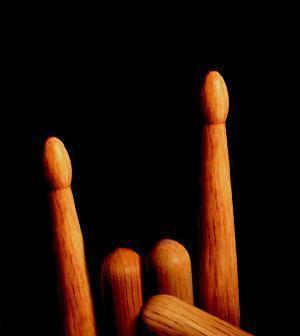"Enter Your Business Name Here"

Technique
Rudiments
Snare Solos
Single Surface Playing
It is important to develop a good sense of technique to form a foundation to build on. Learn to hold and wield the sticks correctly and practice with good technique. This will transfer over to your performance and using "muscle memory" you will be able to play near effortlessly without consciously thinking about stick heights, angles, etc.
Traditional Grip
This is the grip developed by cival war soldiers to compensate for the angle of the snare drum as it hung from a sash while marching. The palm of the left hand will be facing up where the stick is cradled. The right hand will be palm down holding the stick similar to matched grip. This grip is used primarily in marching and jazz playing. Though not as powerful as matched grip, It affords the left hand the ability to play more controlled and with a wider range of dynamics.
This is the grip developed by cival war soldiers to compensate for the angle of the snare drum as it hung from a sash while marching. The palm of the left hand will be facing up where the stick is cradled. The right hand will be palm down holding the stick similar to matched grip. This grip is used primarily in marching and jazz playing. Though not as powerful as matched grip, It affords the left hand the ability to play more controlled and with a wider range of dynamics.
Matched Grip
This is the most commonly used technique for drum set players. Both hands hold the sticks the same way (matched) and should look mirror image to each other. The fulcrum, or leverage point, is about 1/3 of the way up from the back of the stick and pinched between the thumb and index finger. The other 3 fingers will wrap around the underside of the stick and will be used to manipulate the movement of the stick.
The stroke uses a combination of arm, wrist, and fingers, depending on the style, dynamics and application of the playing. Marching uses mostly wrist, drum set players will use more arm to move around the set.
The fingers are used for grace notes and low volume playing as well as to control the subtle movement of the sticks.
This is the most commonly used technique for drum set players. Both hands hold the sticks the same way (matched) and should look mirror image to each other. The fulcrum, or leverage point, is about 1/3 of the way up from the back of the stick and pinched between the thumb and index finger. The other 3 fingers will wrap around the underside of the stick and will be used to manipulate the movement of the stick.
The stroke uses a combination of arm, wrist, and fingers, depending on the style, dynamics and application of the playing. Marching uses mostly wrist, drum set players will use more arm to move around the set.
The fingers are used for grace notes and low volume playing as well as to control the subtle movement of the sticks.
Legatto Strokes and Exercises
This is the perfect set of warm-up exercises. Legatto strokes are used to master control of the sticks from the starting position through the rebound. These exercises stretch out the muscles needed to play freely and help master evenness when shifting from one stick to the other.
This is the perfect set of warm-up exercises. Legatto strokes are used to master control of the sticks from the starting position through the rebound. These exercises stretch out the muscles needed to play freely and help master evenness when shifting from one stick to the other.
Dynamics
This is the range between the softest, quietest note and the loudest, most aggressive note that you can play. Stick heights correlate with the volume of the notes, and attention is paid to the shift between stacatto and leggatto notes.
This is the range between the softest, quietest note and the loudest, most aggressive note that you can play. Stick heights correlate with the volume of the notes, and attention is paid to the shift between stacatto and leggatto notes.
Sticking Patterns
Alternate sticking, double stroke sticking, paradiddles and variations for practice and application.
Alternate sticking, double stroke sticking, paradiddles and variations for practice and application.
Stick Control
This is a summary of sticking patterns in 4/4 time leading with both the right and left hands.
This is a summary of sticking patterns in 4/4 time leading with both the right and left hands.
Double Strokes
Using rebound to get two even notes quickly out of each hand. This technique carries over in to open rolls and many sticking patterns.
Using rebound to get two even notes quickly out of each hand. This technique carries over in to open rolls and many sticking patterns.
Inverted Paradiddles
Paradiddle inversions are a way of exploring the all-purpose sticking pattern using single and double strokes.
Paradiddle inversions are a way of exploring the all-purpose sticking pattern using single and double strokes.
Triple Stroke Exercise
This is a set of 4 exercises using broken sticking patterns in 4/4 time. They promote the ability to use the rebound to "milk" the initial stroke and develops an evenness needed for a triple stroke roll.
This is a set of 4 exercises using broken sticking patterns in 4/4 time. They promote the ability to use the rebound to "milk" the initial stroke and develops an evenness needed for a triple stroke roll.
Ebb and Flow of Single and Double Strokes
Using a technique called phasing, this exercises gets the player to start and stop a roll anywhere in a measure for different durations.
Using a technique called phasing, this exercises gets the player to start and stop a roll anywhere in a measure for different durations.
Alternate Single Stroke Groups
One of the best speed exercises. Start with small groups of alternating notes and increase the duration of the patterns all within a 4/4 format.
One of the best speed exercises. Start with small groups of alternating notes and increase the duration of the patterns all within a 4/4 format.
Triplet Sticking Patterns
This is every sticking pattern using triplets with both a right and left hand lead. The variations are designed to be transitioned in to each other seamlessly.
This is every sticking pattern using triplets with both a right and left hand lead. The variations are designed to be transitioned in to each other seamlessly.
Exercise 1-7
This takes the double and triple stroke exercises and takes it as far as 7 strokes, all within a 4/4 format.
This takes the double and triple stroke exercises and takes it as far as 7 strokes, all within a 4/4 format.
Matrix
This is an exercise that works single, double, triple, and quadruple strokes, and several rhythmic combinations on both the right and left hand. The arrangement is based on the grid (matrix) below. Each pair of notes is repeated on the right and left hand.
This is an exercise that works single, double, triple, and quadruple strokes, and several rhythmic combinations on both the right and left hand. The arrangement is based on the grid (matrix) below. Each pair of notes is repeated on the right and left hand.
Matrix Permutations of 16
Using the patterns from the Matrix to make patterns that are 16 notes long (i.e. measure long patterns) Again, this is every possible permutation of 1, 2, 3, and 4 stroke patterns that can fit into a measure of 4/4 time.
Using the patterns from the Matrix to make patterns that are 16 notes long (i.e. measure long patterns) Again, this is every possible permutation of 1, 2, 3, and 4 stroke patterns that can fit into a measure of 4/4 time.
Natural Sticking with Broken 16th Notes
This covers the natural sticking pattern and how it applies to every broken 16th note pattern possible. It makes a great reference and exercise for both natural sticking and reading/playing broken 16th notes.
This covers the natural sticking pattern and how it applies to every broken 16th note pattern possible. It makes a great reference and exercise for both natural sticking and reading/playing broken 16th notes.
1,1 1,2 1,3 1,4
2,1 2,2 2,3 2,4
3,1 3,2 3,3 3,4
4,1 4,2 4,3 4,4
2,1 2,2 2,3 2,4
3,1 3,2 3,3 3,4
4,1 4,2 4,3 4,4
Stay tuned as videos of these lessons become available.
All of the lesson topics have a written page of music to go along with it. I use these in my private teaching practice and they are available.
Please contact me if you would like the lessons. They all will be included in my method book "Wielding the Sticks".
due to be released early 2009.
aaron@aaronbland.com
All of the lesson topics have a written page of music to go along with it. I use these in my private teaching practice and they are available.
Please contact me if you would like the lessons. They all will be included in my method book "Wielding the Sticks".
due to be released early 2009.
aaron@aaronbland.com

